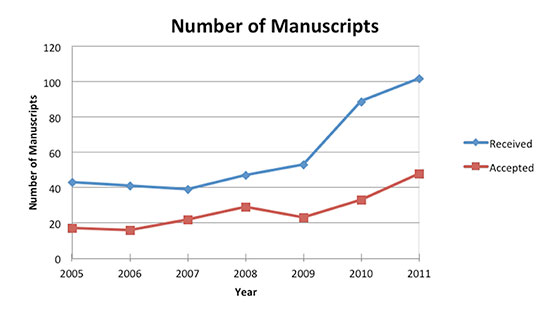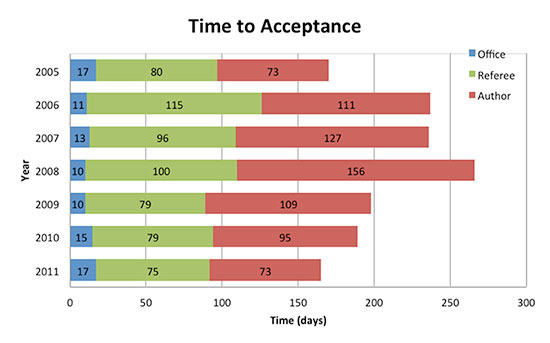Physical Review Special Topics - Physics Education Research: A brief history and future directions
Charles Henderson, Western Michigan University, Senior Editor
Robert Beichner, North Carolina State University, Founding Editor
The purpose of this article is to provide an overview of the journal Physical Review Special Topics–Physics Education Research (PRST-PER). This will begin with a history of why PRST-PER was created in 2005, a picture of how the journal has grown since then, and then conclude with a vision of the future of the journal.
Overview of PRST-PER
Physical Review Special Topics–Physics Education Research (PRST-PER) is the archival research journal for the field of Physics Education Research (PER). The journal covers the full range of experimental and theoretical research related to the teaching and/ or learning of physics. Unlike other journals that publish physics education research, PRST-PER is the only journal that has physics education researchers as its primary audience. As part of the American Physical Society's Physical Review series, PRST-PER shares in and contributes to the reputation of the Physical Review journals as among the leading international journals in Physics.
PRST-PER is an online-only journal published under the terms of the Creative Commons Attribution 3.0 License. This allows authors and others the right to copy, distribute, transmit, and adapt the work, provided that proper credit is given. In addition, because authors pay article-processing charges, the journal can be distributed without charge, thus making it easily accessible to researchers throughout the world.
"APS was very interested in giving the Physics Education Research community a designated and selective journal home within the Physical Review. . . . The field isn't richly funded in every country, so making PRST-PER open access allowed physics education researchers around the world to get to these high-quality articles without a subscription barrier. We knew it was essential as well to work with the American Association of Physics Teachers and the APS Forum on Education to find scholarship options for authors who weren't able to pay the article-processing charges that permit open access."
-Gene Sprouse, APS Editor in Chief.
Origins of PRST-PER
With the Spring 1999 adoption of a "Statement of Research in Physics Education," the American Physical Society (APS) Council recognized a growing interest in PER and supported its inclusion in physics departments. As the field's acceptance expanded, a major stumbling block was the difficulty in finding suitable publication venues. There were a few journals that might publish research on the teaching and learning of physics, but there was no one publication with that as its main focus. This was recognized as impeding the growth of the field because faculty could not make a strong case for promotion or tenure. Conversations between Bob Beichner, Ramon Lopez, Joe Redish and others about the need for a PERspecific journal led Beichner to write a proposal to the National Science Foundation (NSF) to create a web-based publication, along with an internet "homebase" for the PER community. With support from Ted Hodapp (then an NSF Program Officer) and others at NSF, the project was funded and led to the creation of the APS journal as well as the PER-Central.org website. In addition to NSF funds, the project was supported by the APS, the American Association of Physics Teachers (AAPT), and the APS Forum on Education (FEd). (Support was provided to cover article-processing charges for authors able to document need for such support.) Although there was some initial resistance to the journal, three early events helped to alleviate most concerns: 1) APS agreed to have the new PER journal under the Physical Review imprimatur; 2) several senior members from the PER community came out in public support of the journal; and 3) a high profile Editorial Board was named for the journal, chaired by Carl Wieman. PRST-PER began publication in 2005 with Beichner as the founding Editor and David Maloney as the Associate Editor. Sanjay Rebello replaced Maloney as Associate Editor in 2008. In 2011 Beichner announced that he wished to step down as Senior Editor. He was replaced by Charles Henderson in 2012.
Current Status of PRST-PER
Since its beginning, PRST-PER has grown significantly. In this section we will discuss four important aspects of PRST-PER: finances, number of submissions (and acceptance rate), time to acceptance, and Impact Factor.
1. Finances
PRST-PER is currently funded in two important ways. The APS continues to provide approximately half the operating expenses of the publication. The other half is provided by article-processing charges. These charges are paid by authors or their institutions prior to publication of an accepted article. The Physics Education Research Topical Group (PERTG) of AAPT has also recently agreed to provide $10,000 annually to be used to support authors who are not able to pay the article-processing charges. As the journal grows, it is expected that the article processing charges will eventually cover all of the operating expenses.
"Improving physics education will continue to be a priority for APS, and hence we expect to support PRST-PER in appropriate ways until its operating expenses are covered by article-processing charges. This is a sound and valuable investment in the future of physics."
-Joseph Serene, APS Treasurer/Publisher.
2. Number of submissions
The number of submissions to PRST-PER continues to increase (see Figure 1). In 2011 there were 102 manuscripts submitted. Of those, 48 have been accepted for publication. The acceptance rate for manuscripts has remained fairly constant at approximately 45% throughout the journal's lifetime.

Figure 1: Number of manuscripts received and accepted. Note that the number of manuscripts accepted is based on the year that the manuscript was received (even though the manuscript may have been accepted in the following year).
3. Time in Review
One important goal of any scientific journal is to publish important scientific results as quickly as possible. PRST-PER continues to work on decreasing the time from article submission to acceptance. As Figure 2 shows, 2011 was the best year yet, with a total time to acceptance of 165 days. Most of the time to acceptance occurs while the article is with the referees or with the authors (for making revisions). Keep in mind that the author and referee times include all rounds of reviewing and revision.

Figure 2: Time from submission to acceptance. Office: time for processing and routing the manuscript as well as time with the editors. Referee: time that the article is with referees for review. Author: time with the author for making revisions.
4. Impact Factor
All articles published in PRST-PER are indexed on the Web of Science. The Impact Factor is a metric that identifies the number of times, on average, that an article published in the previous two years was cited (by another indexed journal) in a particular year. For example, the 2011 Impact Factor of 0.902 means that, on average, articles published in 2009 and 2010 were each cited a bit less than once in 2011. As Figure 3 shows, the Impact Factor for PRST-PER fluctuates around a four-year average of 1.56. An Impact Factor of 1.00 is sometimes considered as a threshold for a high-quality journal.

Figure 3: Impact Factor of PRST-PER for each of the four years available
Future Directions of PRST-PER
As shown in Figure 1, PRST-PER is currently experiencing rapid growth in terms of the number of submissions. This is an indicator that authors in the PER community see the journal as a high quality publication venue for their research. It is also notable that the percentage of articles submitted by authors outside of the US is now approximately 50% (up from approximately 25% during the first few years of the journal). This is an indicator that the journal is increasing its international visibility.
Although the trajectory of the journal is positive, there is still much to be done to ensure that this trajectory continues. As the journal grows and matures, it is important to maintain and in some cases formalize lines of communication between the journal and the stakeholder groups. Towards this end the journal plans to strengthen ties between the FEd and the AAPT Physics Education Research Topical Group (PERTG). The journal has also developed plans to increase the feedback that referees receive about editorial decisions and to more closely involve the Editorial Board in decision making. Finally, the journal is seeking to strengthen the international vitality of PRST-PER through an increased participation of authors and readers with diverse international perspectives on the teaching and learning of physics.
In order to increase the visibility and utility of the journal both within the PER community and outside, PRST-PER is also in the process of finalizing plans to develop theme issues of the journal. A theme issue will be a set of related articles that seeks to articulate the current state of PER knowledge related to the given theme. The articles will be tied together with an editorial by a Guest Editor that summarizes this knowledge. Thus, it is expected that this set of articles will be of significant value to the PER community as well as a place for those outside the PER community to get an overview of what PER can contribute to various areas of knowledge.
Of course, PRST-PER can only be successful with the help of people like you. If you are not currently in the reviewer pool for PRST-PER, please send a short note to the Editor (prstper@aps. org) with your contact information and areas of expertise. If you receive a request to review a manuscript, remember that the quality and timeliness of your review directly shapes the quality and timeliness of the final article. Finally, in order for PRST-PER to be the archival research journal for the field of PER, it is important for all research-based knowledge in physics education to be represented. When you see high-quality research in physics education that has not yet been published, encourage the researcher to develop an article and submit it to PRST-PER. And of course, please continue your investment in PER by publishing and sharing results through the PRST-PER platform.
Charles Henderson is an Associate Professor of Physics and Science Education at Western Michigan University. He currently serves as the Senior Editor of PRST-PER.
Robert Beichner served as the Founding Editor of PRST-PER. He is an Alumni Distinguished Undergraduate Professor of Physics at North Carolina State University, and heads the North Carolina State University STEM Education Initiative. He is the recipient of the 2011 McGraw Prize in Education.
Disclaimer–The articles and opinion pieces found in this issue of the APS Forum on Education Newsletter are not peer refereed and represent solely the views of the authors and not necessarily the views of the APS.
